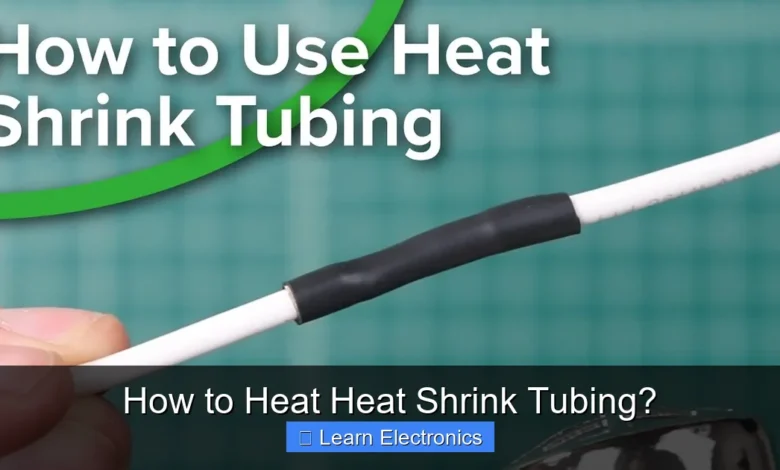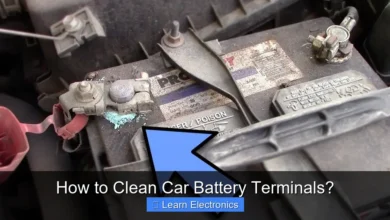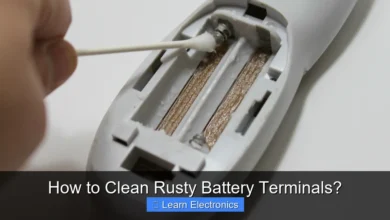How to Heat Heat Shrink Tubing?

How to Heat Heat Shrink Tubing? The most effective way to shrink heat shrink tubing is by applying uniform, controlled heat from a heat gun. This method ensures an even, snug fit, providing reliable insulation and protection for various electrical and mechanical applications.
Understanding the proper techniques for this process is crucial for achieving professional and durable results. Incorrect application of heat can lead to a compromised seal, material damage, or even a failed connection, underscoring the importance of mastering this fundamental skill in electronics and DIY projects.
Quick Answers to Common Questions
What’s the best tool to heat heat shrink tubing?
For the best results, a heat gun is your go-to! It provides consistent, even heat, ensuring your heat shrink tubing shrinks perfectly all around without scorching.
Can I use a lighter or blow dryer to shrink tubing?
While a lighter can work for small pieces of heat shrink tubing in a pinch (just keep the flame moving!), a blow dryer usually doesn’t get hot enough. A heat gun is always preferred for optimal shrinking.
How do I know when the heat shrink tubing is fully shrunk?
You’ll see the heat shrink tubing become taut and conform snugly to the shape of the wire or component underneath, often looking smooth and rigid. If it’s adhesive-lined, you might even see a bit of adhesive ooze out at the ends, which is a good sign!
📑 Table of Contents
- Understanding Heat Shrink Tubing and its Properties
- Essential Tools for Mastering the Technique: How to Heat Heat Shrink Tubing Safely and Effectively
- Detailed Steps: How to Heat Heat Shrink Tubing for Optimal Results
- Best Practices and Advanced Tips
- Common Mistakes to Avoid
- Data Table: Recommended Heating Temperatures and Tools
- Conclusion
Understanding Heat Shrink Tubing and its Properties
Before delving into the methods of applying heat, it’s essential to understand what heat shrink tubing is and how it functions. This foundational knowledge will help you choose the right type of tubing and apply it correctly.
What is Heat Shrink Tubing?
Heat shrink tubing is a type of extruded plastic tube that shrinks radially when heated, typically to between one-half and one-sixth of its original diameter. Made from various thermoplastic materials like polyolefin, PVC, PTFE, and Kynar, it’s widely used to insulate wires, protect against abrasion and environmental elements, bundle wires, and provide strain relief for connections. Its ability to form a tight, protective seal makes it indispensable in countless scenarios.
Key Properties and Shrink Ratios
Different types of heat shrink tubing possess distinct properties suitable for specific applications:
- Material Composition: Polyolefin is the most common due to its flexibility, durability, and wide range of shrink temperatures. Other materials offer specialized properties like high-temperature resistance (PTFE), chemical resistance (Kynar), or very thin walls (PVC).
- Shrink Ratio: This indicates how much the tubing will shrink relative to its original size. Common ratios are 2:1, 3:1, and 4:1. A 2:1 ratio means the tubing will shrink to half its original diameter, while 3:1 will shrink to one-third, and so on. Higher shrink ratios are ideal for covering irregular shapes or connections with large size differences.
- Adhesive Lined: Some tubing comes with an internal layer of thermoplastic adhesive that melts and flows during heating, creating a waterproof, environmentally sealed bond. This is particularly useful for outdoor or harsh environment applications.
- Operating Temperature: Each type of tubing has a specific temperature range at which it effectively shrinks and performs optimally. Exceeding or not reaching this range can lead to poor results.
When to Use Heat Shrink Tubing
The applications for this versatile material are vast:
- Electrical Insulation: Covering exposed wires, splices, and terminals to prevent short circuits and electrical shock.
- Mechanical Protection: Guarding components against abrasion, cuts, and minor impacts.
- Environmental Sealing: Protecting connections from moisture, dust, chemicals, and corrosion, especially with adhesive-lined versions.
- Wire Bundling and Organization: Grouping multiple wires together for neatness and easier management.
- Strain Relief: Providing additional support at connection points where wires might bend or flex, preventing damage.
- Color Coding: Using different colored tubing to identify wires or phases within a system.
Essential Tools for Mastering the Technique: How to Heat Heat Shrink Tubing Safely and Effectively
Selecting the right tool for applying heat is paramount to achieving a professional and lasting shrink. While several options exist, each has its ideal application and potential drawbacks.
Heat Guns: The Professional Choice
For most heat shrinking tasks, a dedicated heat gun is the superior tool. They provide a controlled, consistent stream of hot air, allowing for even shrinkage without scorching the tubing or the underlying components.
- Temperature Control: Many heat guns offer adjustable temperature settings, crucial for matching the specific shrink temperature requirements of different tubing materials.
- Airflow Control: Adjustable airflow allows for precise application, especially in confined spaces or when working with delicate components.
- Nozzles: Concentrator nozzles help direct heat more precisely, while reflector nozzles wrap heat around wires, ensuring even heating.
- Safety: Heat guns generate dry heat, reducing the risk of fire compared to open flames, and are generally safer for electronics.
To use a heat gun effectively, hold it a few inches away from the tubing, moving it constantly to distribute heat evenly until the tubing shrinks tightly and securely around the component.
Lighters and Butane Torches: Cautionary Use
While convenient for small, quick jobs, lighters and butane torches should be used with extreme caution due to the open flame. They are best suited for polyolefin tubing on non-sensitive components.
- Risk of Scorching: The intense, direct flame can easily burn or melt the tubing, damaging the insulation and potentially the wire underneath.
- Uneven Shrinkage: It’s difficult to apply heat evenly with an open flame, often resulting in uneven shrinkage or bubbling.
- Soot and Residue: Flames can leave soot deposits on the tubing, affecting its appearance and potentially its integrity.
- Flammable Materials: Extreme care must be taken to avoid igniting surrounding materials.
If you must use a flame, hold the tubing far enough away to use the very tip of the flame, constantly rotating the tubing and moving it through the heat zone quickly to prevent localized overheating.
Soldering Irons: Niche Applications
A soldering iron can be used for very small diameter heat shrink tubing in tight spaces where a heat gun might be too bulky. This method requires a specific technique to avoid direct contact and damage.
- Indirect Heat: Do not touch the soldering iron directly to the tubing. Instead, hold the iron close enough for the radiated heat to cause shrinkage.
- Limited Area: Only practical for very short lengths of small diameter tubing.
- Risk of Melting: Direct contact or prolonged proximity can melt the tubing.
Ovens and Infrared Heaters: Industrial Scale
For large batches or specific industrial applications, ovens or infrared heaters provide a highly controlled and uniform heating environment. These are generally not practical for individual DIY or small-scale electronics work.
- Batch Processing: Ideal for shrinking many pieces simultaneously.
- Precise Temperature Control: Ovens offer very stable and even temperature distribution.
- Specialized Equipment: Requires dedicated industrial equipment.
Detailed Steps: How to Heat Heat Shrink Tubing for Optimal Results
Following a systematic approach ensures proper application and a durable, aesthetically pleasing finish. This section outlines the essential steps for achieving the best results when shrinking tubing.
Preparation is Key
- Measure and Cut: Select the correct diameter tubing. It should be large enough to slide over the component but small enough to shrink down to a snug fit. Cut the tubing to the required length, typically allowing for a slight overhang on each side of the area to be covered for full protection.
- Clean the Surface: Ensure the wire or component is clean and free of oils, dirt, or debris. This is especially critical for adhesive-lined tubing, as contaminants can compromise the seal.
- Position the Tubing: Slide the tubing over the component before making any connections, especially if the component is larger than the tubing’s shrunk diameter. Once the connection is made, slide the tubing into its final position, centered over the area to be protected.
Applying Heat Evenly
The goal is to apply heat uniformly around the entire circumference of the tubing. Uneven heating leads to poor shrinkage and a weak seal.
- Heat Gun Technique: Hold the heat gun a few inches away from the tubing. Begin heating from one end of the tubing, slowly rotating the work piece or moving the heat gun around it. Work your way along the length of the tubing, ensuring all sides receive adequate heat.
- Observe the Shrinkage: As heat is applied, the tubing will begin to shrink, first becoming translucent (if applicable), then conforming tightly to the shape beneath. You’ll often see small beads of adhesive oozing out from the ends of adhesive-lined tubing, indicating a good seal.
- Constant Motion: Keep the heat source in constant motion to prevent overheating any single spot. This is crucial for preventing scorching or melting.
Observing the Shrinkage
Properly shrunk tubing will appear smooth, tight, and uniform. There should be no wrinkles, loose spots, or bubbles. For adhesive-lined tubing, a small, even bead of adhesive around the edges confirms a good environmental seal.
Cooling Down
Once the tubing has fully shrunk, allow it to cool naturally. Avoid touching or manipulating the tubing while it’s still hot, as this can deform the plastic and weaken the seal. If it’s adhesive-lined, the adhesive needs to set as it cools to form a strong bond.
Best Practices and Advanced Tips
Elevate your heat shrink application from adequate to exceptional with these insights and techniques.
Temperature Control and Overheating
Always refer to the manufacturer’s specifications for the recommended shrink temperature of your specific tubing. Overheating can lead to brittleness, cracking, or melting of the tubing, compromising its protective qualities. Underheating, conversely, will result in incomplete shrinkage, leaving a loose or exposed connection.
- Start Low: If your heat gun has adjustable temperature settings, start with a lower temperature and gradually increase it until shrinkage begins. This helps you find the optimal setting without risk of damage.
- Monitor Closely: Pay close attention to the tubing’s appearance. If it starts to bubble or smoke, you’re applying too much heat.
Airflow and Ventilation
Good ventilation is important, especially when working with adhesive-lined tubing or certain plastic types, as they can produce fumes. Ensure your workspace is well-ventilated, or consider working outdoors if practical.
- Directed Airflow: Use concentrator nozzles on your heat gun to direct hot air precisely where needed, minimizing heat exposure to surrounding components that might be sensitive.
Achieving a Professional Finish
- Smooth Movement: Continuous, smooth movement of the heat source is key to avoiding wrinkles and achieving a sleek, even finish.
- Overlap: When joining two pieces of tubing or shrinking over a particularly long section, ensure there’s sufficient overlap between sections to maintain full coverage.
- Pre-heating: In cold environments, lightly pre-heating the component and tubing can sometimes aid in achieving better, more uniform shrinkage, especially with adhesive-lined types.
Dealing with Different Materials
- Thin-Wall Tubing: Requires less heat and more delicate application to avoid melting.
- Thick-Wall Tubing: Demands more sustained heat for complete shrinkage, often benefitting from reflector nozzles to encompass the entire circumference.
- Adhesive-Lined Tubing: Requires sufficient heat to melt the internal adhesive layer, often indicated by a slight oozing from the ends. Ensure complete melting for a watertight seal.
- High-Temperature Tubing (e.g., PTFE): Needs much higher temperatures than standard polyolefin, necessitating a high-power heat gun capable of reaching those temperatures.
Common Mistakes to Avoid
Understanding potential pitfalls can save time, material, and prevent compromised connections.
Uneven Shrinkage
This is often caused by inconsistent heat application. Failing to move the heat source or rotate the tubing adequately can leave sections unshrunk, wrinkly, or loosely fitted. Always aim for a uniform, smooth, and tight appearance across the entire length.
Burning or Melting
Applying too much heat, holding the heat source too close, or prolonged heating in one spot can scorch, melt, or brittle the tubing. This not only destroys the tubing but can also damage the underlying wires or components. Signs include bubbling, charring, or excessive smoking.
Insufficient Heat
If the heat applied is too low or not sustained long enough, the tubing will not shrink fully. This results in a loose fit, poor insulation, and a compromised seal, especially for adhesive-lined types where the adhesive might not fully melt and flow.
Contamination Issues
Failing to clean the surface of the wire or component before applying tubing can lead to poor adhesion, particularly with adhesive-lined varieties. Dirt, oil, or flux residue can prevent the adhesive from bonding effectively, undermining the environmental seal.
Data Table: Recommended Heating Temperatures and Tools
This table provides a general guide for common heat shrink tubing types. Always consult the manufacturer’s datasheet for precise specifications.
| Tubing Material Type | Typical Shrink Temperature Range | Recommended Heat Source | Key Characteristics |
|---|---|---|---|
| Polyolefin (Standard) | 90°C – 120°C (194°F – 248°F) | Heat Gun (Adjustable) | Flexible, durable, general purpose, good insulation. |
| Polyolefin (Adhesive Lined) | 100°C – 135°C (212°F – 275°F) | Heat Gun (Adjustable, higher temp range) | Environmental sealing, waterproof, strong adhesion. |
| PVC | 100°C – 130°C (212°F – 266°F) | Heat Gun (Low-medium setting) | Thin wall, flexible, good electrical insulation. |
| Kynar (PVDF) | 140°C – 175°C (284°F – 347°F) | High-Temp Heat Gun | High chemical and abrasion resistance, flame retardant. |
| PTFE (Teflon) | 327°C – 350°C (621°F – 662°F) | Very High-Temp Heat Gun, Oven | Extremely high temperature resistance, chemical inertness, low friction. |
| Elastomeric | 120°C – 170°C (248°F – 338°F) | High-Temp Heat Gun | Flexible, high performance, good for harsh environments. |
Conclusion
Successfully shrinking heat shrink tubing is a fundamental skill for anyone working with electronics, wiring, or various DIY projects. By understanding the properties of different tubing types, selecting the appropriate heating tool, and following proper application techniques, you can ensure durable, professional, and reliable results. Always prioritize safety, apply heat evenly, and observe the tubing’s response to achieve an optimal fit and seal. With practice, mastering this valuable technique will become second nature, enhancing the quality and longevity of your work.
Frequently Asked Questions
What tools can I use to heat heat shrink tubing?
The most effective tools for heating heat shrink tubing are a heat gun or a specialized heat shrink oven for larger volumes. For smaller tasks or delicate components, a mini torch with a controlled flame can also be used, but extreme care is necessary to avoid scorching the material.
What is the ideal temperature to heat heat shrink tubing?
The ideal temperature varies depending on the specific type of heat shrink tubing, but it generally ranges between 90°C (194°F) and 200°C (392°F). Always check the manufacturer’s specifications on the product packaging for the most accurate temperature recommendations for your particular tubing.
How do I properly apply heat to heat shrink tubing?
Apply heat evenly by moving the heat source back and forth along the heat shrink tubing, starting from one end and working your way to the other. Rotate the component if possible to ensure uniform shrinkage around the entire circumference for a secure seal.
Can I use a lighter to heat heat shrink tubing?
While a lighter can technically shrink heat shrink tubing, it is not recommended as a primary method due to its inconsistent and high localized heat. Lighters can easily scorch or burn the tubing and underlying wires, leading to a weak or compromised insulation and seal.
How do I know when heat shrink tubing is fully shrunk?
Heat shrink tubing is fully shrunk when it conforms tightly to the component, showing no gaps or wrinkles, and sometimes appears slightly glossy. If you are using adhesive-lined tubing, you might also notice a small amount of adhesive oozing from the ends, indicating a good seal has formed.
Are there any safety precautions I should take when heating heat shrink tubing?
Always work in a well-ventilated area to dissipate any fumes, and wear appropriate personal protective equipment like safety glasses to protect your eyes. Be mindful of hot surfaces, as heat guns and heated tubing can cause burns, and ensure flammable materials are kept away from the heat source.



